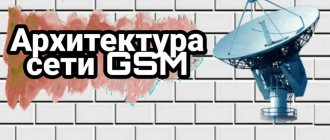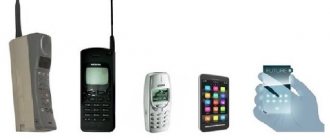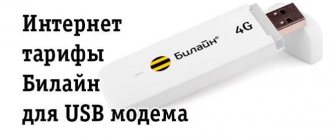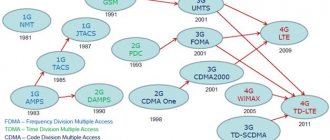In total, the evolution of mobile communications took place in the following order - 1G, 2G, 3G and 4G. At the time of writing and publishing this article, the generation of new 5G mobile communications is already being tested in some countries and cities:
- USA in cities: Houston, Indianapolis, Los Angeles and Sacramento
- South Korea in various major cities, as well as in Seoul.
- Switzerland – 54 cities.
- Great Britain.
- Italy.
- Spain.
- Germany in several cities: Bonn and Berlin.
- China – 50 cities.
Also, preparations are already underway for the introduction of the sixth generation of mobile communications - 6G in the second half of the 2020s - 2030s.
Cellular generations
- this is a set of functionalities for network operation within the framework of certain standards, including: subscriber registration, information transfer, encryption, roaming, as well as a set of various services provided to the subscriber. And each generation includes different standards, which are improved with each generation. So which communication standard is better? Let's figure it out now!
These cellular communication standards are divided into 2 types:
- Analogue – 1G
- Digital – All other mobile communication standards (2G, 3G, 4G, 5G).
| Cellular generations: | 1G | 2G | 2.5G | 3G | 3.5G | 4G | 5G (new generation cellular communications) |
| Cellular standards: | AMPS, TACS, NMT | TDMA, CDMA, GSM, PDC | GPRS, EDGE (2.75G), 1xRTT | WCDMA, CDMA2000, UMTS | HSDPA, HSUPA, HSPA, HSPA+ | LTE-Advanced, WiMax Release 2 (IEEE 802.16m), WirelessMAN-Advanced | |
| Advantages: | Analog standard | Digital standard, SMS support | Packet data transfer, speed increase | Increasing capacity and speed up to 2 Mbit/s | Speed increase | Increased capacity, IP-oriented network, multimedia support, increased speed up to hundreds of Mbit/s | Speed from 1 Gbit/s, average number of simultaneous users - 1 million per km², latency up to 1 ms, increased energy efficiency |
| Data transfer rate: | 1.9 kbps | 9.6 - 14.4 kbit/s | 115 kbit/s (1 phase), 384 kbit/s (2 phase) | up to 3.6 Mbit/s | up to 42 Mbit/s | 100 Mbit/s - 1 Gbit/s | from 1 Gb/s, 6.5 Gb/s |
| Operating frequency (MHz): | 900,1800. | 900,1800,2100. | 800,1800,2600. | ||||
The first generation is 1G.
In 1984, the first generation of mobile communication technology, 1G, came into commercial use and it operated on an analog data transfer method. At that time, analogue systems were used and only voice calls were possible. After all, it was developed only for voice calls. The cost of a minute of conversation in the 80s was very high and a mobile phone in those years was considered an expensive and rare pleasure.
The first generation had its drawbacks, namely:
- Low capacity.
- Lack of any encryption.
- It was possible to listen to voice calls.
- Roaming problems.
- High weight and cost of user terminals.
- There is a complete lack of effective methods to combat signal fading, even when the subscriber moves.
M2M market today
The M2M market currently refers primarily to the market of wireless mobile devices equipped with SIM cards and designed to transmit telemetry information without human intervention.
According to Berg Insight estimates, in 2014 the number of wireless M2M connections in the world exceeded 200 million. The figure is very modest compared to the total number of connected subscriber devices. The Russian market for wireless M2M connections, according to MTS, contains about 6 million SIM cards, of which more than 60% are installed on vehicles to monitor their location, track fuel consumption, sales, etc.
Business consumers consider their high cost, low connection speed and connection instability to be the key problems hindering the promotion of M2M services on the Russian market. These factors are cited by 59, 45 and 20% of M2M service users, respectively, as determining factors when making a decision to connect to the service (data from J'son & Partners Consulting).
Cellular communication standards – 2G.
- GSM
- GPRS
- EDGE
Main advantages compared to 1G:
- High network capacity.
- What has appeared in comparison with the previous generation is encryption of information during transmission.
- Data transfer has become possible.
- Much better noise immunity.
- Possibility of creating roaming.
- The weight and cost of subscriber terminals has become less.
GSM.
For the first time, 2G generation networks began operating in 1991. The main innovation and advantage of the first generation is the digital method of transmitting information, thanks to which many people have loved the possibility of sending messages - SMS. During the creation of the second generation, Europe decided to create a single standard called GSM. Also, a notable feature of the second generation of communications was that calls were encrypted thanks to digital encryption, and the peak speed reached 115.2 kbit/s.
GPRS.
After GSM, a new and advanced technology appeared - GPRS. This cellular communication standard allows the user to transfer data to another device on the Internet. This system was created for packet data transmission with a possible speed of no more than 170 kbit/s. This standard was applied for:
- Satellite vehicle tracking.
- Mobile and, in turn, secure access for employees to corporate networks, mail and information servers of enterprises.
- Access to the Internet from a mobile device with an acceptable data transfer speed at that time, as well as charging for transmitted/received data.
EDGE.
After GPRS, newer EDGE technology appeared. The main differences from previous technology are the way data is encoded, which makes it possible to transmit a much larger volume of data. Peak achievable data transfer rate, no more than 474 kbit/s.
To enhance voice communications at 900 MHz, we recommend the following ready-made kits:
- Cellular booster kit BS-GSM-65-kit
- Kit for strengthening cellular communications BS-GSM-75-kit
- Cellular booster kit BS-GSM-80-kit
We strongly recommend choosing these kits based on the required amplification power, as well as the strength of the input signal.
Add-on for GSM - GPRS/EDGE
The most common wireless data transmission standards in Russia are GPRS and EDGE. They are an add-on to GSM cellular communication technology. The data is collected in packets and transmitted through a virtual channel, which is provided to the subscriber for the duration of the GPRS session connection. To connect to the Internet, you can use a cell phone that supports GPRS or EDGE. Theoretically, the maximum possible data transfer rate when using GPRS is 171.2 Kbps, when using EDGE – 473.6 Kbps. In practice, the speed is much lower and averages 40-45 Kbps. Although these speeds are enough to carry out simple operations such as opening and viewing a page through a web browser, reading news and mail. Media content and downloading files are out of the question here, but, nevertheless, the user has a certain mobility at his disposal. GPRS/EDGE technology is available to all subscribers of MTS, Beeline, Megafon.
3G communication standards.
- CDMA2000
- UMTS (or W-CDMA)
- HSPA
- HSPA+
Advantages of the 3G generation over the past:
- Better immunity to interference
- Increased signal security
- Less power consumption
Mobile communications in the third generation are based on packet data transmission. This network allows you to both arrange video conferences and watch movies, videos and other content on any mobile device. In the third generation network, there is one very important advantage: improved protection against interruptions in mobile communications when the subscriber moves. As you move away from one cellular operator tower, another station immediately begins to pick it up. It begins to transmit more and more information, while the previous station receives less and less, and this continues until the client completely leaves its service area. With high-quality network coverage, the chance of a communication breakdown during such an interception is completely minimized.
If you need to boost your 3G or 4G signal, then these 2 sets are perfect for you, depending on the required signal boost power:
- Ready kit for strengthening 3G-4G Internet A13
- Ready-made 4G Internet booster kit N5
You can also choose a kit for strengthening mobile Internet from our catalog:
- 3G-4G modems with antennas (set)
CDMA2000.
A standard that provides data transmission rates of up to 2048 kbit/s for stationary objects. for users with a travel speed of no more than 3 km/h, the speed can reach approximately 384 kbit/s, and for subscribers who move at speeds up to 120 km/h – 144 kbit/s.
W-CDMA.
W-CDMA - Wideband Code Division Multiple Access. When used, it allows you to obtain speeds over short distances up to 2 Mbit/s and over long distances with full mobility up to 384 Kbit/s. To achieve such speeds, the network requires a wide frequency band, which is why the bandwidth in this technology is 5 MHz.
HSPA.
The next stage of the third generation was the HSPA network - high-speed packet access. At first, the data transfer speed reached 14.4 Mbit/s, but now, it is possible to achieve much higher values - 84 Mbit/s and more.
HSPA+.
This communication standard is an improved version of the standard - HSPA. It contains complex 16QAM (uplink/downlink) and 64QAM (downlink) modulations, and also introduced MIMO technology, which is used only for downloading - downlink. MIMO technology will allow you to get a peak download speed of 42 Mbit/s and upload speed of up to 11 Mbit/s.
M2M and IoT - what's the difference?
All forecasts about the “explosive” growth in the number of M2M connections are based on the new M2M concept - the Internet of Things (IoT), which is part of the more general concept of the Internet of Services (IoS). The term “M2M device” covers both traditional proprietary telemetry and telecontrol tools (which include the vast majority of M2M devices in use today, including network-dependent wireless ones), as well as network- and application-independent IoT devices. And “Internet of Things” devices are only devices that have the ability, through a free IP connection (at the physical level, usually Wi-Fi), to interact with various telemetry and telecontrol systems implemented as cloud and/or online services. That is, the “Internet of Things” is cloud telemetry and telecontrol.
Cloud systems are capable of providing arbitrarily detailed optimization management of an arbitrarily wide range of control objects, and not only objects as a whole (“smart home”, “smart car”, etc.) and their systems (energy supply, lighting, air conditioning, etc.). etc.), but also individual elements of these systems, down to a separate light bulb in the lighting system. This feature is the reason for the wide spread in forecast estimates of the number of such devices: the number of “smart light bulbs” and other components of controlled objects can actually reach tens and hundreds of billions (in some forecasts, trillions).
4G mobile communication standards.
- LTE Advanced
- LTE Advanced Pro
LTE is a wireless data transmission standard and is also a development of the GSM/UMTS standards. The purpose of this new standard was to improve bandwidth and data rates using a new method of digital signal processing and modulation that had been developed at the turn of the millennium. Another goal was to simplify the entire architecture of IP-based networks, while significantly reducing the delay in data transmission in the mobile network.
Advantages of this generation over the past:
- High data transfer speed
- Improved voice quality
- Speed is better maintained when the subscriber moves
- Low latency in data transfer.
To strengthen the signal in 4G networks, we can recommend these kits to you:
- Ready-made 3G-4G Internet amplification kit No. A1
- Ready-made 3G-4G Internet amplification kit No. A20
LTE Advanced.
LTE Advanced is a major improvement to the LTE network standard. This technology received stated speeds of up to 1 Gbit/s for fixed subscribers and 300 Mbit/s for mobile subscribers.
LTE Advanced Pro.
This standard is a more improved version of the standard - LTE Advanced Pro. Possible data transfer rates are up to 3 Gbit/s. This standard also supports other new technologies that are directly related to the 5G network, which allows in the near future to support the LTE Advanced Pro standard, the new fifth generation network - 5G.
Who will build 5G networks
In May 2021, the FAS Russia approved an agreement on the joint construction of 5G networks, VimpelCom and MegaFon. These operators will have to ensure equal access to 5G to all market participants.
At the same time, as of 2021, the prospects for the development of 5G in Russia are vague. The decision to allocate specific frequencies for the 5G standard has not yet been made. Presumably, the new fifth standard will come into effect in our country no earlier than 2024. Perhaps by 2030 we will already see the sixth generation of mobile communications? Who knows…
But while 5G is still in development, the pressing question remains: which existing mobile communications standard is better?
What communication standards do Russian operators support?
Cellular standards and operators in Russia are in the frequencies that are listed in the table below:
| Russian operator | Yota, Megafon, Beeline. MTS, Tele2 | Yota, Megafon, MTS, Beeline | Yota, Megafon, MTS, Beeline, Tele2 (SPb) | Yota, Megafon, MTS, Beeline, Tele2 | Yota, Megafon, MTS, Beeline, Tele2 |
| Communication standard. | 4G | 2G,3G | 2G,3G,4G | 3G | 4G |
| Frequency (MHz) | 800 | 900 | 1800 | 2100 | 2600 |
LTE Cat.0, LTE Cat.1
One of the main requirements for an M2M/IoT device is low power consumption. To implement this requirement, the LTE standard included requirements for subscriber devices Cat.0, Cat.1 and LTE NB (Narrow Band).
In theory, IoT devices will be able to operate on Cat.1-enabled LTE networks for at least 10 years on a single battery. Many IoT devices will operate without external power supply, that is, the duration of their operation will be determined precisely by energy consumption indicators; mass replacement of batteries is not provided. Energy savings are ensured by support for the Power Saving Mode functionality. A device with this functionality is mainly in sleep mode and turns on only when necessary. Support for Power Saving Mode on the side of LTE network equipment is expected to be standardized in 2021. In November 2015, Ericsson demonstrated the operation of a Cat.1 device based on the Altair FourGee-1160 chipset on the AT&T network using release 16A. This is a very promising direction, especially considering that LTE networks will take over the functions of working with numerous M2M devices, which currently mostly operate via GSM networks.
Which mobile communication standard is better?
At the moment, the fastest communication is provided in 4G networks. The fourth generation of communication already has fairly good coverage in Russian cities, and also has a very good data transfer speed of 100 Mbit/s - 1 Gbit/s, which makes its use very desirable for many Russians users and clients. But you shouldn’t forget that power consumption in 4G is usually slightly higher than in the previous generation (3G). According to some data, energy consumption in fourth generation networks is 20% more than in 3G. And here the conclusion is very appropriate. Each user, if possible, already chooses 4G or 3G to use. To have more speed and energy consumption or vice versa, it depends on the person and the case
Where will 5G networks be installed?
One idea is to place base stations for 5G networks on rooftops. However, now management companies are in no hurry to provide operators with access to common property to install equipment.
In addition, operators have to pay a percentage for the use of roofs, basements and other common areas. Soon this problem is planned to be solved at the state level, which will allow the introduction of 5G networks at a faster pace.
NB-LTE
NB-LTE - Narrow Band LTE for IoT applications - another subset of the LTE standard, which is planned to be enshrined in 3GPP LTE Rel.13 in early 2021. NB-LTE is intended for a variety of IoT applications, which are characterized by low traffic consumption . NB-LTE is expected to have even more modest resource requirements than LTE Cat.1, Cat.0 and LTE MTC. Expected specification: 180 kHz - frequency band for UL and DL (for LTE MTC - 1 MHz), DL uses 15 kHz frequencies and OFDMA modulation, 3.75 kHz - guard interval, UL uses FDMA or GMSK, as an option there may be SC-FDMA. Expect improved indoor coverage and the ability to serve multiple low-bandwidth devices, especially those that are not too latency-sensitive. Narrowband allows for low-cost chipsets and devices with very low power consumption, which should allow devices to operate for a long time on batteries (such as a large silver-zinc cell or an AAA alkaline cell), up to a year or more. The standard can be implemented on regular LTE networks by allocating multiple resource blocks or by using blocks in the LTE guard band. In principle, isolated deployment of the NB-LTE network in a dedicated portion of the spectrum is also possible. The standard is expected to be widely used, since, unlike various analogues, it is supported by 3GPP. There is, however, a fear that by the time the final version of Rel.13 is released they will not have time to implement NB-LTE, then it will be standardized in Rel.14. But LTE MTC will be included in Rel.13 with almost 100% probability. This standard provides lower power consumption than Cat.0 and better coverage than Cat.0. It loses to NB-LTE, but is almost ready to be included in the standard.
Relevance
The topic under study is very relevant because it is due to the significant expansion of telecommunications capabilities with the advent of cellular communications in the 1980s, as well as the rapid and significant transformation of the territorial structure of the entire established communication system in the world. Along with other circumstances, the development of cellular communications is both a result and an important factor in the globalization process, largely responsible for increasing the contact and mobility of people, the conductivity of the environment and the consolidation of the global information space.











